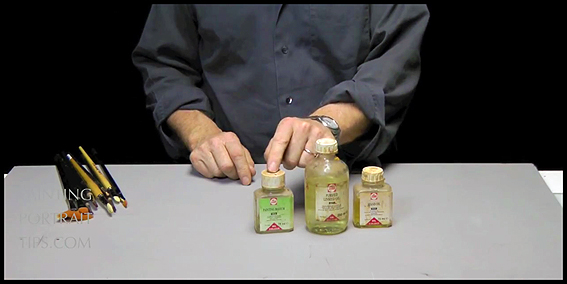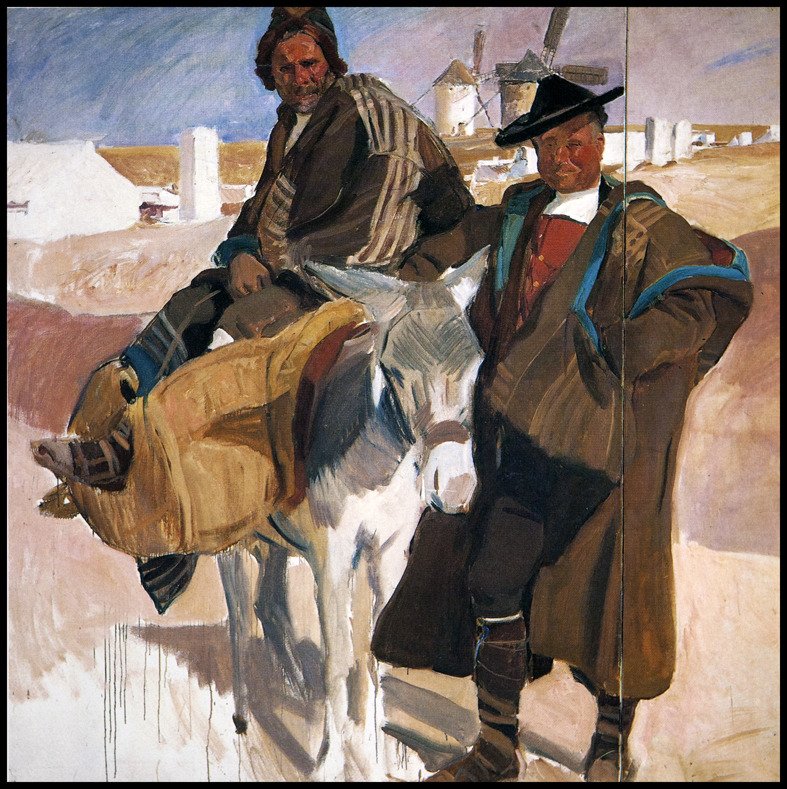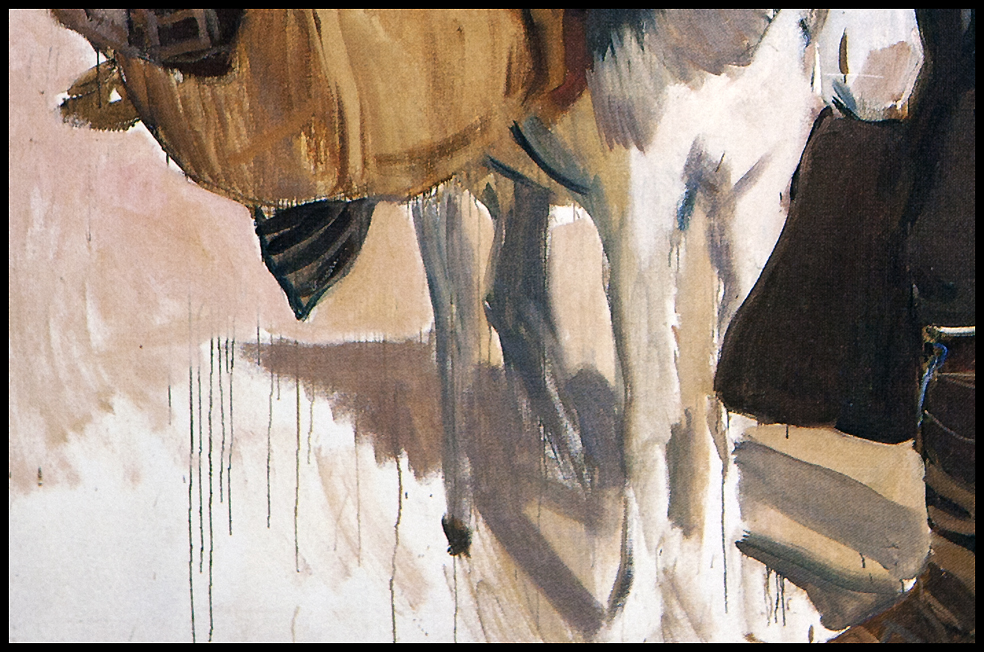Fat-over-Lean

Dogmas in painting do not exist and there is no such thing as law and order. Don´t trust painters and art teachers who say “Never do this or that, or this particular colour is forbidden on your palette”. In painting there are as many theories as there are painters. So my advice is: Find your own method and struggle your way to succes. Having said this I must give away this rule of thumb. “Fat over Lean“. (And that is no dogma, but an advice.)
Start a painting lean and finish it fat. Lean for instance is spirit or turpentine, fat for instance is linseed oil. Why is this important? Apart from the chemical explanation there is a practical one. If you start mixing your oil paint with linseed oil from the beginning you will have trouble later when you must add more paint to your canvas. The oily underground is slippery and it becomes difficult to continue. Diluting the paint with turpentine in the beginning gives the possibility to build op a good amount of paint later. If you take a close look to this unfinished painting of Sorolla you see the first thinned layer of paint running down the canvas. Later he adds thick layers of paint.


Below more information that I found on the internet
The system of “fat-over-lean” (or: flexible over less flexible) must be followed if a painting is built up of various layers. A following layer can only be applied once the previous layer is dry enough for it to no longer dissolve. Meticulous use of the various solvents is advised in connection with the adherence and durability of the individual layers.
Through anchoring, oil colours adhere to a porous ground. The oil forms “anchors” allowing the paint layer to adhere after drying. If a thick layer of pure oil colour were to be allowed to dry, then this would not be porous enough for a good adherence of the next layer. For the first layer, the paint is thinned with white spirit or turpentine. They thin the oil in the paint and allow a certain amount of paint to now cover a larger surface area. The solvent evaporates making the first paint layer porous again. Due to the thinning each painted surface has too little oil to form a strong film; the film is ‘lean’ and weak. This is remedied by the second layer of paint.
Once the first layer is sufficiently dry the second layer of paint is applied, thinned with painting medium. A good painting medium consists of three components: oil, resin and solvent. The extra added oil feeds the lean first paint layer by filling the pores that are formed by the evaporated solvent. At the same time this second layer can also adhere well to the underlying layer. The evaporation of the white spirit forms new pores which allow for the adherence of a subsequent layer. The third ingredient, resin, makes the paint layer stronger.
If we then apply a third layer, we need to use a medium that is yet fatter to feed the underlying layers. If this layer is also the last, glazing paint layers are usually applied.
Various glazing mediums can be used, such as Talens Glazing Medium, Alkyd Medium, Venetian Turpentine and Stand Oil. These mediums are fatter than the painting medium and do not give the paint any brush stroke. If a painting is built up of more layers, then the mentioned thinning agents can be mixed proportionately from lean to increasingly fatter or the first layers can be mixed with a decreasing amount of solvent. The following layers can be mixed with a painting medium, and if a glaze is desired, the last layer with one of the above glazing mediums.

Hee Ben, weer helder en duidelijk. Wat ik me wel afvraag is dat onze oude gegevens op de Leave a Reply staan, nu heb die veranderd en dit is een test of jij mijn reply met de huidige gegevens door krijgt. Fijne zondag, xx, Agnes
Hallo Agnes. Ja hoor het is prima doorgekomen.
Ben
Ben – thank you so very much for your explanation of layering and fat over lean. I can now accept and understand the need for this, having only previously been told about the cracking that occurs when you paint the other way from fat to thin. I have come to painting somewhat late in life, a few years pre-retirement, but its like for the first time in my 60 years that I have found my identity. And your explanation of the fat over lean process has been a light bulb moment for me. THANK YOU. XX
Great to hear! Thank you Glynis.
Ben
First: I think it’s funny how Sorolla cut the top of his subject’s head off (riding the donkey) and the the feet of the man standing! I understand it creates a flowing, unbroken mass from top-to-bottom, but if I were to do that in my paintings today, they would receive serious scorn.
Second: I am interested in the diffused light above your easel. Is it 5000K, translucent photo diffusion material? What angle for maximum coverage?
Hi Ben,
Thank you for your valuable lessons. I’m so glad I found your work on Youtube!
I’ve been working with various mediums, ie. Galkyd & Liquin….but I have a reaction to them.
I know several artists who only use walnut alkyd or just walnut oil as a medium. They have sworn off solvents. I would like to know your view of this.
Thanks,
Belinda
Hi Belinda. Are you allergic to oils and turpentine? Or is it only the solvents? I usually hardly use medium. The paint I use has already a good “running” quality. I once tried water mixable “oil” paint. I liked the strong pigment.
However it takes a while to get familiar with it. But it is certainly worth while to give it a try.
Best.
Ben
Hi Ben,
I have just started oil painting (with water mixable W&N Artisan paints) – as where I live I can’t have lots of turpentine and stuff going down the drains, and this seems a lot more environmentally friendly.
I finished my first painting which I am so happy with, but I’ve been so scared since, worrying I haven’t abided too well to the fat over lean rule, and that it will ruin and crack.
I didn’t use any mediums, (well I tried a bit of the Artisan fast drying one, for a few strokes, but it made the paint too moveable and transparent like a wash and I preferred just using the thicker paint and spreading it thin). Also when people talk about layers, I have found I haven’t waited for layers to completely dry, as I liked the tackiness to sometimes blend the colours.
I am about to start my next one now, please let me know if its ok to not use any mediums, and also how much fat over lean? Do you always have to wait for full layers to dry? This is hard to tell over a big painting as I work in bits, I don’t know where one layer finishes and the next begins… Will my first painting ruin and how soon will it crack?
Sorry for all the questions, you just seem to explain things so well, and I’m a little heartbroken my painting will ruin, and at least want to go forward in the right direction.
Many thanks,
Lucy
Hi Lucy. First of all I have to say this. “Every artist has to make at least 100 bad paintings before he really can get started”. So the sooner you make this amount the quicker you make progress. But I understand you don´t want to ruin what you have done already. The problem is that I don´t have much experience with water mixalble oil paint. Last summer-courses in France a student used it and found it really a surprise! Perfect quality and good pigments. I have here a test box with watermixalbles of the dutch brand Talens: Cobra. I must have a try because I promised the manufacturer. Any way I found on their website a good FAQ page where you will find all the answers you asked me. Go to : http://www.talens.com/en-us/information/frequently-asked-questions/water-mixable-oil-colours/
Please let me know if you what you think. At all times I am here to help you. Kind regards.
Ben
Hi Ben,
Thank you so much for your swift reply. That has really helped.
So I am under the impression you don’t have to use mediums if you don’t want to? You can do a whole painting without?
Apparently you use water-mixable just like oils, so I also wanted to ask – I’ve mixed some ‘fast drying’ medium in with some paint for the background so that less paint covers more. Does this mean every layer above this will also have to have medium in it, to abide by the fat over lean? Even if this layer is relatively dry?
Thanks Ben,
Lucy 🙂
Hi, Ben.
Great article. Much easier to understand than most sites and you go deeper into the explanation as well. Thank you for that.
One word of advise for everyone: Do not be discouraged but just keep searching and learning as you go. I’ve obtained a huge amount of knowledge by talking with other artists, searching the web, buying good instructional books, and contacting the manufacturers – without ever taking an art class. I also purchase mini canvases (only a couple of inches square) and experiment on them. I test drying times, mixing mediums, etc. to see what will happen before I continue on to the picture I’m creating. Start with smaller canvases (or boards, etc.) to get “the feel” of it and build up your confidence. If your first few pieces don’t turn out as you thought they would, just chalk it up to a learning experience and move on to bigger and better things. You didn’t start walking the day you were born; you had to fall, get up and keep trying till you eventually were running. Consider it a joyful activity and grow through it.
Jan